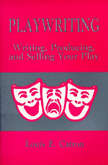“Without Louis E. Catron’s Playwriting: Writing, Producing, and Selling Your Play, I don’t think I’d have had a professional writing career. I always thought of it as an instruction manual, which could have been titled ‘How To Become a Real Writer.’ Inspirational yet eminently practical, I now use the book to teach my own screenwriting classes and seminars. Catron’s book was, and remains, simply the best text out there for aspiring playwrights, screenwriters, and anyone who’s serious about writing. It’s been a constant companion on my own Writer’s Journey, and I wouldn’t trade it for anything.” — Stephen Berger, screenwriter and educator
“. . . it makes for compelling reading and, once begun, is difficult to put aside. Paradoxically, Catron’s is also a book which the reader will also, we believe, quickly but temporarily set aside in order to capture immediately on paper some new idea or rediscovered technique inspired by Catron’s amiable and often eloquent prose. In our opinion, this is a book that avoids the pitfalls and embraces the triumphs of every other work currently available on the subject of playwriting and should be held as essential reading in the eyes of dramatists of all levels of their careers.” —The Playwright’s Companion

272 pages, $35.95 list
0-88133-564-9
978-0-88133-564-4
© 1984
paperback
eBook availability
Playwriting
Writing, Producing, and Selling Your Play
A practical guidebook for effective playwriting! This imaginative and enthusiastic book is designed especially for those having the desire to create, to entertain, and to express their emotions and ideas. It features a practical, down-to-earth emphasis on craft and structure rather than on theory as its step-by-step approach shows just what’s involved in creating a stageworthy play. Coverage includes basic considerations such as plot and character development, theme and dialogue as well as production and publication considerations. Outstanding features: offers concrete writing guidelines; includes exercises that get the reader going and inspirational anecdotes; presents excerpts from such classics as Macbeth, The Glass Menagerie, and The Dumb Waiter that help the student grasp key concepts; lists plays to read for instruction; includes valuable information not usually found in comparable collections.
About the Author: One of America’s leading authors of books and articles for playwrights, Professor Catron’s writing reflects his years of teaching playwriting as well as his extensive experience directing modern and classical plays and musicals. He shares this accumulated practical knowledge with his readers as he guides them in a friendly, personal way through the process of creating stageworthy scripts.
About the Author: One of America’s leading authors of books and articles for playwrights, Professor Catron’s writing reflects his years of teaching playwriting as well as his extensive experience directing modern and classical plays and musicals. He shares this accumulated practical knowledge with his readers as he guides them in a friendly, personal way through the process of creating stageworthy scripts.
Reactions
Part I. THE MAKER OF PLAYS
1. Why Playwriting?
2. Prelude to Playwriting
3. “A Maker of Plays”
Part II. PREPARING TO WRITE
4. The Credo
5. The Writer’s Journal
6. Guidelines for the First Play
7. The One-Act Play: Theatre’s Iconoclast
8. The Scenario
9. The Sound of a Breaking Harp-String
10. The Scene Not Written, the Speech Unspoken
11. Script Format: Preparing the Final Version
12. Don’t Talk About It, Write It!
Part III. THE SIX ELEMENTS OF DRAMA
13. An Introduction to “The Six Elements of Drama”
14. Plot: Part One
15. Plot: Part Two
16. Plot: Part Three
17. Character: Part One
18. Character: Part Two
19. Thought
20. Diction
21. Music and Spectacle
Part IV. THE PLAYWRIGHT IN THE WRITING CLASS
22. Giving and Accepting Criticism in the Writing Class
Part V. NOW THAT YOU’VE FINISHED YOUR PLAY
23. Production and Publication
24. Your Play Is Produced!
1. Why Playwriting?
2. Prelude to Playwriting
3. “A Maker of Plays”
Part II. PREPARING TO WRITE
4. The Credo
5. The Writer’s Journal
6. Guidelines for the First Play
7. The One-Act Play: Theatre’s Iconoclast
8. The Scenario
9. The Sound of a Breaking Harp-String
10. The Scene Not Written, the Speech Unspoken
11. Script Format: Preparing the Final Version
12. Don’t Talk About It, Write It!
Part III. THE SIX ELEMENTS OF DRAMA
13. An Introduction to “The Six Elements of Drama”
14. Plot: Part One
15. Plot: Part Two
16. Plot: Part Three
17. Character: Part One
18. Character: Part Two
19. Thought
20. Diction
21. Music and Spectacle
Part IV. THE PLAYWRIGHT IN THE WRITING CLASS
22. Giving and Accepting Criticism in the Writing Class
Part V. NOW THAT YOU’VE FINISHED YOUR PLAY
23. Production and Publication
24. Your Play Is Produced!